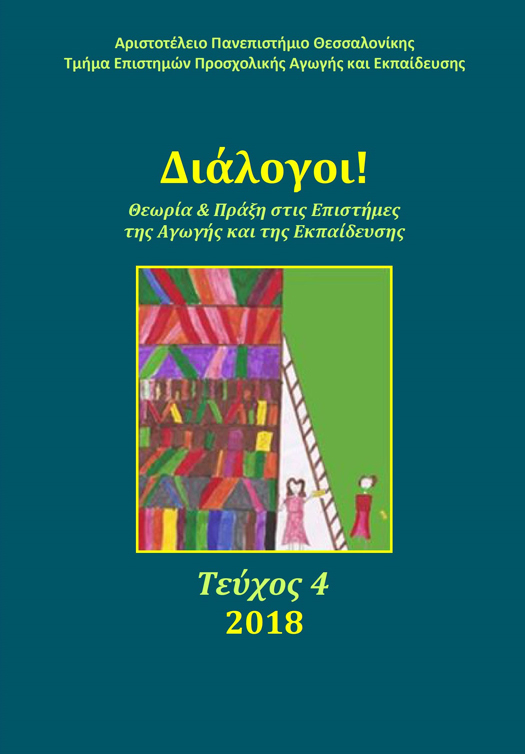Η ενίσχυση της ικανότητας αφήγησης φανταστικών ιστοριών παιδιών προσχολικής ηλικίας

Περίληψη
Σκοπός της παρούσας εργασίας ήταν να εξετάσει την επίδραση ενός προγράμματος παρέμβασης για την ενίσχυση της κατανόησης του δομικού πλαισίου των ιστοριών σε παιδιά προσχολικής ηλικίας με στόχο την παραγωγή φανταστικών ιστοριών. Το δείγμα της μελέτης αποτέλεσαν 56 παιδιά ηλικίας 5-6 ετών τα οποία φοιτούσαν σε 5 τάξεις νηπιαγωγείων της πόλης των Χανίων στην Κρήτη. Τα παιδιά του δείγματος χωρίστηκαν σε δύο ομάδες, μία πειραματική και μία ομάδα ελέγχου. Το πρόγραμμα εφαρμόστηκε μία φορά την εβδομάδα για 8 εβδομάδες. Στα παιδιά της πειραματικής ομάδας διαβάστηκαν 8 βιβλία με αφηγηματικά κείμενα. Σε κάθε συνεδρία, μετά την ανάγνωση του βιβλίου, εφαρμόστηκε μια πολυεπίπεδη στρατηγική μέσω της οποίας τα παιδιά εκπαιδεύτηκαν στην κατανόηση της δομής της ιστορίας και στην παραγωγή φανταστικών ιστοριών. Στα παιδιά της ομάδας ελέγχου διαβάστηκαν τα ίδια 8 βιβλία χωρίς να εφαρμοστεί κάποιο συγκεκριμένο πρόγραμμα ενίσχυσης του δομικού πλαισίου των ιστοριών. Τα αποτελέσματα έδειξαν ότι η στρατηγική που εφαρμόστηκε στο πρόγραμμα παρέμβασης βελτίωσε σημαντικά την ικανότητα των παιδιών της πειραματικής ομάδας να κατανοήσουν τα δομικά στοιχεία των ιστοριών και να παράγουν πιο οργανωμένες φανταστικές ιστορίες από ότι τα παιδιά της ομάδας ελέγχου. Επιπλέον, τη μεγαλύτερη βελτίωση στην παραγωγή φανταστικών ιστοριών την παρουσίασαν τα παιδιά που είχαν χαμηλό βαθμό επίδοσης στα αφηγηματικά κριτήρια. Τέλος, η βελτίωση των παιδιών διατηρήθηκε και μετά την είσοδό τους στο δημοτικό σχολείο.
Λεπτομέρειες άρθρου
- Πώς να δημιουργήσετε Αναφορές
-
Βρετουδάκη Ε., & Τάφα Ε. (2018). Η ενίσχυση της ικανότητας αφήγησης φανταστικών ιστοριών παιδιών προσχολικής ηλικίας. Διάλογοι! Θεωρία και πράξη στις επιστήμες αγωγής και εκπαίδευσης, 4, 62–82. https://doi.org/10.12681/dial.16130
- Τεύχος
- Τόμ. 4 (2018)
- Ενότητα
- Επιστημονική Αρθογραφία

Αυτή η εργασία είναι αδειοδοτημένη υπό το CC Αναφορά Δημιουργού – Μη Εμπορική Χρήση – Παρόμοια Διανομή 4.0.
Οι συγγραφείς των άρθρων που δημοσιεύονται στο Διάλογοι! Θεωρία και Πράξη στις Επιστήμες Αγωγής και Εκπαίδευσης διατηρούν τα δικαιώματα πνευματικής ιδιοκτησίας επί των άρθρων τους, δίνοντας στο περιοδικό το δικαίωμα της πρώτης δημοσίευσης. Άρθρα που δημοσιεύονται στο Διάλογοι! Θεωρία και Πράξη στις Επιστήμες της Αγωγής και Εκπαίδευσης διατίθενται με άδεια Creative Commons 4.0 και σύμφωνα με την άδεια μπορούν να χρησιμοποιούνται ελεύθερα, με αναφορά στον/στη συγγραφέα και στην πρώτη δημοσίευση για μη κερδοσκοπικούς σκοπούς και με δικαίωμα τροποποίησης μόνον με παρόμοια διανομή (αν αναμείξετε, τροποποιήσετε, ή δημιουργήσετε πάνω στο υλικό, πρέπει να διανείμετε τις δικές σας συνεισφορές υπό την ίδια άδεια όπως και το πρωτότυπο).
To Τμήμα Επιστημών Προσχολικής Αγωγής και Εκπαίδευσης του Αριστοτέλειου Πανεπιστημίου Θεσσαλονίκης και το Εθνικό Κέντρο Τεκμηρίωσης διατηρούν το δικαίωμα να δημοσιεύουν, να αναπαραγάγουν, να παρουσιάζουν στο κοινό, να διανέμουν και να χρησιμοποιούν άρθρα που δημοσιεύονται στο Διάλογοι! Θεωρία και Πράξη στις Επιστήμες Αγωγής και Εκπαίδευσης σε οποιοδήποτε μέσο και μορφή είτε μεμονωμένα είτε ως μέρη συλλογικών έργων, για όλο το χρόνο διάρκειας προστασίας της πνευματικής ιδιοκτησίας και για όλες τις χώρες του κόσμου.
Αυτό περιλαμβάνει ενδεικτικά, και όχι αποκλειστικά, το δικαίωμα δημοσίευσης των άρθρων σε τεύχη του περιοδικού Διάλογοι! Θεωρία και Πράξη στις Επιστήμες Αγωγής και Εκπαίδευσης, αναπαραγωγής και διανομής μεμονωμένων αντιγράφων των άρθρων, αναπαραγωγής ολόκληρων των άρθρων σε άλλη έκδοση του Τμήματος Επιστημών Προσχολικής Αγωγής και Εκπαίδευσης του Αριστοτέλειου Πανεπιστημίου Θεσσαλονίκης και του Εθνικού Κέντρου Τεκμηρίωσης και αναπαραγωγής και διανομής των άρθρων ή περίληψης αυτών με χρήση πληροφορικού συστήματος αποθετηρίου.


